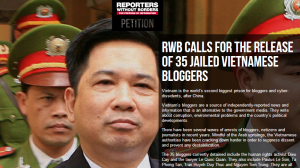Transparency International, December 2017
The Global Corruption Barometer (GCB), conducted by Transparency International (TI) since 2002 in over 150 countries worldwide, collects data on citizens’ perceptions and experiences of corruption, their views on the government’s anti-corruption efforts, as well as the effectiveness of anti-corruption measures. Since 2010, Towards Transparency, TI’s National Contact in Vietnam has developed three GCB Vietnam country reports (2010, 2013 and 2017).
The 2017 Vietnam GCB is based on primary data collected in 18 provinces in Vietnam through face-to-face interviews during the period May 2016-June 2016. The report also provides policy makers, development partners, civil society and other stakeholders with information that indicates what must be done to ensure that Vietnam’s anti-corruption strategy is more effective as well as how best to mobilize citizens and society in anti-corruption efforts.
The following article provides a short summary of the full 2017 Vietnam GCB findings, which will be available online in English and Vietnamese languages in late
December 2017 in Towards Transparency’s website (https://towardstransparency.vn).
What is the GCB ? The Global Corruption Barometer (GCB) is the unique worldwide survey on citizen views and experiences of corruption, developed by Transparency International (TI). The GCB examines people’s views on corruption in their country in general, and in which institutions the problem of corruption is most severe in particular. It also provides a measurement of people’s experience of bribery in the past year across different services. The survey looks at how effective people think the government has been in stopping corruption and also probes their willingness to get involved personally in the fight against corruption. The GCB complements the Corruption Perception Index (CPI1) in the way it focuses on the views of ordinary people, rather than the opinions of businesses and country experts. It also takes into account people’s experiences of corruption.
What is the GCB useful for? Policy-makers can use the survey results to identify public institutions and services that are seen as affected by corruption and where bribes are most frequently paid by citizens. This enables anti- corruption policies and measures to effectively target the services and institutions most prone to corruption in a country. Key questions can be compared from year to year and used for monitoring the progress in stopping corruption at the national level. Civil society and journalists can use the GCB as evidence of people’s views in a country with respect to this important issue. The data can be employed to raise awareness about the impact of
corruption on people’s everyday lives. It can also be used to mobilize public participation in anti-corruption measures and efforts, by demonstrating people’s willingness to engage personally through the means of reporting incidences of corruption for example. The private sector can use the Global Corruption Barometer to better understand the political climate in a country and the strength of national institutions.
Finally, the GCB is a rich and unique data source for the research community, providing both the breadth of country coverage as well as the valuable time series data for a number of important issues concerning corruption.
Vietnam GCB 2017 key findings
- People think corruption is on the rise
A majority, 72% of respondents believe that corruption in the public sector is a serious or very serious problem, compared to 61% reported in the 2013 Vietnam GCB edition; 58% believe that corruption increased over the past year, which is slightly higher than the number recorded in 2013which is 55%.
- Citizens experience a high level of corruption 65% of those who had contact with any of the six surveyed public services Public school officers/teachers, Public health officials, ID documents, Utility service providers, Police officers, Judges or court officials) in the 12 months prior to June 2016 report they had to pay bribes. This is the highest rate among surveyed ASEAN countries and the second highest of the countries surveyed in the Asia-Pacific region, only after India.
Tỷ lệ người dân phải hối lộ khi sử dụng dịch vụ công
|
Tên quốc gia
|
Tỷ lệ (%)
|
|
Việt Nam
|
65
|
|
Thái
|
41
|
|
Myanmar
|
40
|
|
Campuchia
|
40
|
|
Indonesia
|
32
|
|
Malaysia
|
23
|
|
ASEAN
|
35
|
|
Châu Á- Thái Bình Dương
|
28
|
- Police and tax officials, followed by business executives, are considered to be the most corrupt groups in Vietnam
Vietnamese citizens perceive police (57%), tax officials (47%) and business executives (37%) as the most corrupt groups. Notably, more people perceive business executives as corrupt than they did in 2013 (33%).
- Very few people report corruption as they believe nothing would be done
Only 3% of those who paid a bribe while accessing a public service reported the incident to a competent government authority. The top reason for not reporting corruption is that “nothing will be done”.
- People are becoming more pessimistic about the effectiveness of government action against corruption
One out of two respondents (49%) believe that government anti-corruption actions are ineffective, which significantly increases compared to that in 2013 (37%). Notably, people in rural areas seem to be more disappointed than those in urban areas.
- Refusing to pay a bribe is the most effective action that ordinary citizens can take against corruption
37% of respondents say refusing to pay a bribe is the most effective thing an ordinary citizen can do to combat corruption. Nevertheless, 15% feel completely powerless in fighting corruption for they think that “ordinary people cannot do anything”.
Key recommendations
- Stop bribery in public services
The government of Vietnam (GoV)should focus its anti-corruption efforts on the groups perceived to be most corrupt, especially where people experience the highest rates of corruption (police, public healthcare and public education).
To gain public trust, the GoV should accelerate its efforts to address systemic problems that allow corruption to spread in the public sector(e.g. continuing to increase transparency in administrative procedures through effective implementation of the newly approved Law on Access to Information; clarifying legal provisions to reduce the discretion that allows authorized officials to abuse their positions).
- Engage citizens and society in anti-corruption efforts
An enabling environment for stronger engagement with citizens and society needs to be established. Over half of the Vietnamese surveyed say that ordinary people can make a difference in combating corruption. Current legislation for whistleblower protection needs to be reinforced. Anti
-corruption agencies should develop user-friendly reporting mechanisms, ensure appropriate follow-up to whistleblowers’ disclosures, and implement outreach programs to empower people to report corruption.
- Address corruption in the business sector
Businesses should apply international standards and good practice, and commit to doing business with integrity. They should demand their business partners to apply them too, to create a more enabling business environment and increase their reputation.
Height Insoles: Hi, I do believe this is an excellent site. I stumbledupon …
http://fishinglovers.net: Appreciate you sharing, great post.Thanks Again. Keep writi…
Achilles Pain causes: Every weekend i used to pay a quick visit this site, as i w…






December 7, 2017
Vietnam Global Corruption Barometer 2017: views and experiences from Vietnamese citizens
by Nhan Quyen • [Human Rights]
Transparency International, December 2017
The Global Corruption Barometer (GCB), conducted by Transparency International (TI) since 2002 in over 150 countries worldwide, collects data on citizens’ perceptions and experiences of corruption, their views on the government’s anti-corruption efforts, as well as the effectiveness of anti-corruption measures. Since 2010, Towards Transparency, TI’s National Contact in Vietnam has developed three GCB Vietnam country reports (2010, 2013 and 2017).
The 2017 Vietnam GCB is based on primary data collected in 18 provinces in Vietnam through face-to-face interviews during the period May 2016-June 2016. The report also provides policy makers, development partners, civil society and other stakeholders with information that indicates what must be done to ensure that Vietnam’s anti-corruption strategy is more effective as well as how best to mobilize citizens and society in anti-corruption efforts.
The following article provides a short summary of the full 2017 Vietnam GCB findings, which will be available online in English and Vietnamese languages in late
December 2017 in Towards Transparency’s website (https://towardstransparency.vn).
What is the GCB ? The Global Corruption Barometer (GCB) is the unique worldwide survey on citizen views and experiences of corruption, developed by Transparency International (TI). The GCB examines people’s views on corruption in their country in general, and in which institutions the problem of corruption is most severe in particular. It also provides a measurement of people’s experience of bribery in the past year across different services. The survey looks at how effective people think the government has been in stopping corruption and also probes their willingness to get involved personally in the fight against corruption. The GCB complements the Corruption Perception Index (CPI1) in the way it focuses on the views of ordinary people, rather than the opinions of businesses and country experts. It also takes into account people’s experiences of corruption.
What is the GCB useful for? Policy-makers can use the survey results to identify public institutions and services that are seen as affected by corruption and where bribes are most frequently paid by citizens. This enables anti- corruption policies and measures to effectively target the services and institutions most prone to corruption in a country. Key questions can be compared from year to year and used for monitoring the progress in stopping corruption at the national level. Civil society and journalists can use the GCB as evidence of people’s views in a country with respect to this important issue. The data can be employed to raise awareness about the impact of
corruption on people’s everyday lives. It can also be used to mobilize public participation in anti-corruption measures and efforts, by demonstrating people’s willingness to engage personally through the means of reporting incidences of corruption for example. The private sector can use the Global Corruption Barometer to better understand the political climate in a country and the strength of national institutions.
Finally, the GCB is a rich and unique data source for the research community, providing both the breadth of country coverage as well as the valuable time series data for a number of important issues concerning corruption.
Vietnam GCB 2017 key findings
A majority, 72% of respondents believe that corruption in the public sector is a serious or very serious problem, compared to 61% reported in the 2013 Vietnam GCB edition; 58% believe that corruption increased over the past year, which is slightly higher than the number recorded in 2013which is 55%.
Tỷ lệ người dân phải hối lộ khi sử dụng dịch vụ công
Tên quốc gia
Tỷ lệ (%)
Việt Nam
65
Thái
41
Myanmar
40
Campuchia
40
Indonesia
32
Malaysia
23
ASEAN
35
Châu Á- Thái Bình Dương
28
Vietnamese citizens perceive police (57%), tax officials (47%) and business executives (37%) as the most corrupt groups. Notably, more people perceive business executives as corrupt than they did in 2013 (33%).
Only 3% of those who paid a bribe while accessing a public service reported the incident to a competent government authority. The top reason for not reporting corruption is that “nothing will be done”.
One out of two respondents (49%) believe that government anti-corruption actions are ineffective, which significantly increases compared to that in 2013 (37%). Notably, people in rural areas seem to be more disappointed than those in urban areas.
37% of respondents say refusing to pay a bribe is the most effective thing an ordinary citizen can do to combat corruption. Nevertheless, 15% feel completely powerless in fighting corruption for they think that “ordinary people cannot do anything”.
Key recommendations
The government of Vietnam (GoV)should focus its anti-corruption efforts on the groups perceived to be most corrupt, especially where people experience the highest rates of corruption (police, public healthcare and public education).
To gain public trust, the GoV should accelerate its efforts to address systemic problems that allow corruption to spread in the public sector(e.g. continuing to increase transparency in administrative procedures through effective implementation of the newly approved Law on Access to Information; clarifying legal provisions to reduce the discretion that allows authorized officials to abuse their positions).
An enabling environment for stronger engagement with citizens and society needs to be established. Over half of the Vietnamese surveyed say that ordinary people can make a difference in combating corruption. Current legislation for whistleblower protection needs to be reinforced. Anti
-corruption agencies should develop user-friendly reporting mechanisms, ensure appropriate follow-up to whistleblowers’ disclosures, and implement outreach programs to empower people to report corruption.
Businesses should apply international standards and good practice, and commit to doing business with integrity. They should demand their business partners to apply them too, to create a more enabling business environment and increase their reputation.